Features of the marquetry technique

Since ancient times, wood has been used for interior decoration. The art of decorating wood, called marquetry, originated many centuries ago, but still has not lost its relevance. Beautiful patterns made on a wooden surface have a long history. The popularity of this type of decoration is constantly growing and admiring. Inlaid with oak, mahogany, juniper, cherry, ash, walnut - all kinds of natural wood shades allow you to create masterpieces. Even the simplest drawing made using the marquetry technique looks impressive.
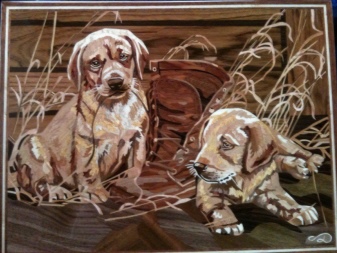



What it is?
Literally translated from French, the word marquererie means "mosaic". Mastering marquetry is available to anyone with artistic taste and imagination of the creator.
Wood inlay done in layered mosaic with pieces of wood veneer, shavings, dried flower petals, glitter and beads can be defined as a marquetry style.


The essence of the technology for performing the technique is as follows: The thinnest cuts of natural wood of valuable species of wood are harvested in the form of plates, after cutting in the desired direction, the wood particles are folded into a pattern and glued to the base in the form of a wooden or other decorated surface. The selection of shades should be carried out in such a way that the drawing looks the most realistic - this principle is considered inlay. With the help of mosaic pieces of veneer, the craftsmen create paintings of high artistic value, variety and texture. This kind of decor is most often decorated with walls, ceilings and floors, furniture, as well as any other surfaces. In addition to the plot picture, an ornament can be assembled from a mosaic. The marquetry technique makes it possible to additionally use ivory slices, mother-of-pearl shells of molluscs, metal plates, stone or ceramic materials together with wood veneer.



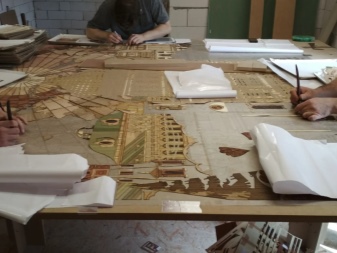
Historical reference
Studying the history of the appearance of marquetry, art historians have found that this trend originated several millennia ago. The origins of wood inlay were found in the territory of the Ancient East, and found household items decorated using the marquetry technique served as scientific artifacts of such conclusions. In addition, the use of mosaic art has left its mark on the details of ancient figurines, as well as on the ruins of architectural buildings. During the study of the tombs in the burial places of the Egyptian pharaohs, various things and household items were found, the decoration of which was the inlay of the thinnest cut plates of mahogany and black cedar.

At the site of the excavations of Ancient Greece and Rome, archaeologists have found many items that were decorated using the mosaic technique with wood and stone materials. It was discovered that the ancient Greek craftsmen were already decorating furniture and decorating the interior of the premises in the style of marquetry.
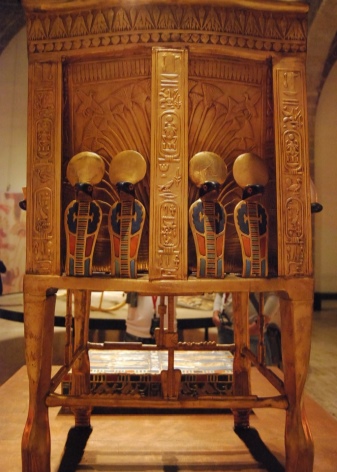

It is known for certain that the architecture of ancient Italy during the 9th-13th centuries had a tradition of mosaic decorations. During the Renaissance, Italian craftsmen created inlaid objects using precious grades of stone and marble. Church utensils of those times were traditionally decorated with precious mosaic patterns.




By the end of the 16th century, the marquetry technique had already taken the form of a separate applied direction in art. This was facilitated by the invention of the first machine designed for cutting the thinnest veneer plates from a single piece of wood. So the art of marquetry began to be widely used for the decoration of furniture products. Veneer was obtained from valuable species of trees, most often in those days it was pink, mahogany and ebony - the most valuable types of wood. During the Renaissance, marquetry gained massive popularity; it was hardly possible to find a person who was unfamiliar with interior decoration or furniture in mosaic technique. Due to the widespread prevalence, products decorated with such mosaics have become more affordable in price. The technique of marquetry was improved and developed, thanks to which individual masterpieces of the masters of that time have survived to our times.



At the end of the 17th century, French craftsmen began to use sets of pieces of veneer, which were made according to a template, in cladding work. The mosaic technique was quickly adopted throughout Europe and replaced the previously known decoration method called intarsia. The development of the marquetry technique reached its peak in the 18th century. Craftsmen created unique canvases, and in the mass production of furniture, sets of mosaics were used, the details of which could decorate not only flat rectangular products, but also curvilinear bends of inlaid surfaces.


In the middle of the 18th century, the technology of wooden inlay reached the territory of Russia. By the decree of Peter I, the best carpenters were sent to England and Holland to comprehend the science of inlay. The Russian school of marquetry masters was formed during the reign of Empress Catherine the Great. Wooden mosaic was used to decorate furniture, walls, floors, ceilings. The popular subjects of that period were motifs of scenes from the Bible, geometric ornaments, landscapes and natural compositions. Russian craftsmen, improving in the new art, developed such techniques as wood burning, pickling and tinting of veneer to give it new unusual shades. Such techniques made it possible to create paintings with naturalistic shades and originality.


Species overview
Over time, the technology for making mosaics has become so perfect that it made it possible to obtain a three-dimensional image using the 3D technique. It has always been difficult to create a three-dimensional pattern, but experienced craftsmen perform it with the highest virtuosity. Today, the most popular subjects are natural landscapes, as well as the creation of floral patterns. Geometric patterns of various shapes are also very popular. Motives from the Bible, genre compositions, images of birds and animals remain relevant in our time. The technique of ignition, etching, and engraving is widely used to this day. Marquetry mosaics are used to decorate door leaves, decorative wall panels, exclusive furniture, tables, wardrobes and dressers of various shapes and purposes. Russian masters have made a huge contribution to the development of such a trend in art as marquetry. Many mosaic paintings are now recognized as unique masterpieces.




The marquetry technology involves fixing the details of which the pattern is made directly on the inlaid base. Parts of the mosaic are pre-cut and then glued to the workpiece. The technique of marquetry today is divided into 2 directions.

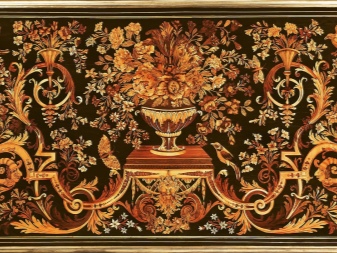
Intarsia
This term was introduced into marquetry technology by Italian masters. In addition to veneer made of natural wood species, surface finishing could be supplemented by other materials: pieces of bone, parts of mother-of-pearl shells, large fish scales, semi-precious and even precious stones, metal, ceramics. With the help of such materials, it is possible to create a three-dimensional image, which in modern language is called 3D technology.All components of the mosaic are carefully selected in shape, color shades, texture. The components of the pattern are cut into the texture of the blank material:
- parts are pre-selected by color and texture, after which the component parts are cut out of them along the contours of the pattern;
- details are processed, polished, tinted - it all depends on the color scheme of the source and the master's idea;
- on the surface of the workpiece, a symmetrical recess is cut out for each part, equal to the thickness of the mosaic part;
- a typesetting part of the image is inserted and glued into the recess.

The pieces of the mosaic may vary in thickness, but together they should form a single whole canvas. This approach differs from the canons of classical marquetry, where a thin piece of wood veneer is applied to the surface of the workpiece.



Cladding
This approach consists in gluing cut-out pattern blanks to the surface of the products. Often, cladding is performed by gluing mosaic parts onto a plywood sheet prepared according to specified dimensions. A decorative lining is made along the edges of the plywood, inside which the pattern is laid out. The cover and the plot of the drawing are made in such a way that all the component parts coincide and form a single whole canvas of the plot.


To inlay any product or make a picture using the marquetry technique, the master must follow some rules:
- the grain texture of the wood veneer should be positioned as intended in the original drawing;
- it is possible to achieve a three-dimensional image using different types of wood, or if this is not possible, then the pieces of the mosaic will have to be tinted in one way or another;
- smooth transitions from one part to another are achieved by sharpening the veneer corners, as well as raising or lowering certain areas in the image;
- to create the most accurate and realistic image, it is necessary to use the thinnest cuts of wood.
The technique of making marquetry is very diverse. Using various techniques, you can achieve an image in beauty and quality comparable to the real works of art of the great masters.
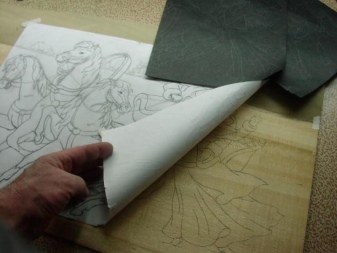



Applications
Finishing in the technique of marquetry takes a lot of time and effort from the master; it is a very laborious process that requires not only certain skills, but also perseverance. Each master has his own unique handwriting, so the objects, finished using this technique, have their own individual appearance. From an ordinary object - a box, table, casket or tabletop - you can make a real unique copy. Today, even inexpensive furniture products are decorated with mosaics made from pieces of veneer. Even if the entire set of objects is decorated with the same type of veneer puzzles, the appearance of such objects is transformed. The veneer applique can imitate portraits or look like a painting. The color scheme of wood veneer will allow you to create a mountain landscape, depict flowers or a plot with a particular character.






Furniture craftsmen who make exclusive furniture decorate it using the mosaic technique. Furniture of this level is created for a long time and painstakingly, but the result is excellent. Such furniture is highly valued and can even be inherited. The veneer applique can decorate interior doors. A pattern can be a geometric pattern, nature, mountains, flowers, birds. The marquetry technique is widely used in the manufacture of souvenir products. Inlay is used in the design of boxes, gift boxes, mirrors, wall panels. Sometimes craftsmen are ordered to make a family coat of arms, which becomes an adornment of the family estate and is passed on to the heirs as a family heirloom.






Applique made of natural wood veneer is used to decorate many items related to various spheres of human life.... These can be wall niches, room partitions or screens, icons, clocks, writing desk utensils are made using the marquetry technique.






For more details on the marquetry technique, see the following video.













The comment was sent successfully.